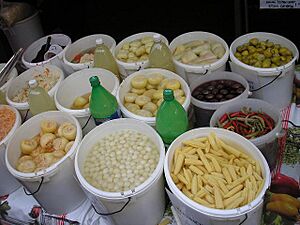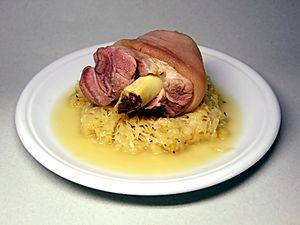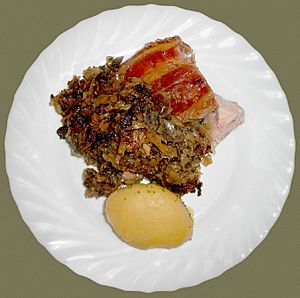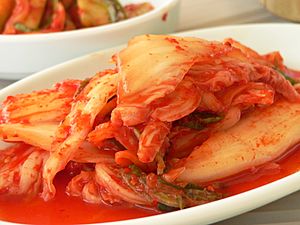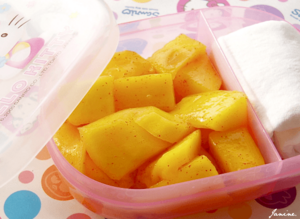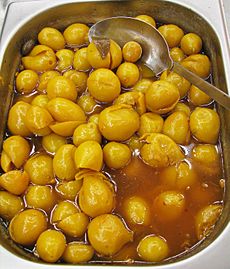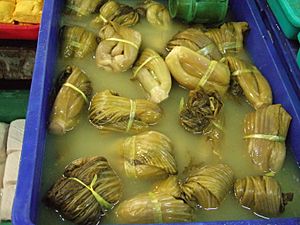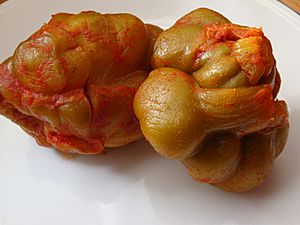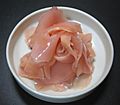List of pickled foods facts for kids
Pickling is a super old and clever way to keep food fresh for a long time. It also adds amazing new flavors! When you pickle food, you usually soak it in a special liquid like salty water (called brine) or vinegar. This stops bad germs from growing and helps the food last. Some pickled foods are also fermented, which means tiny good germs help change the food, making it even more delicious and sometimes healthier.
| Top - 0-9 A B C D E F G H I J K L M N O P Q R S T U V W X Y Z |
What are Pickled Foods?
Pickled foods are items that have been preserved using a process called pickling. This method helps food stay good to eat for much longer than it would normally. It also gives food a unique, tangy, and often salty or sour taste.
How Does Pickling Work?
The main idea behind pickling is to create an environment where harmful bacteria cannot grow. This is usually done by:
- Adding lots of salt: This draws water out of the food and makes it too salty for many bad germs.
- Using vinegar: Vinegar is acidic, and most bad bacteria can't survive in acidic conditions.
- Fermentation: Sometimes, good bacteria are allowed to grow. These bacteria produce acids (like lactic acid), which naturally preserve the food and give it special flavors. Think of how yogurt is made!
Pickling has been used for thousands of years, long before refrigerators were invented. It was a vital way for people to store food through winter or on long journeys.
Types of Pickled Foods
Lots of different foods can be pickled! Here are some popular examples from around the world.
A
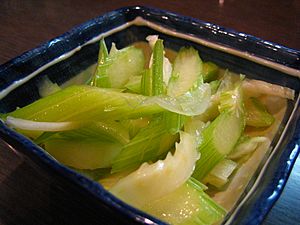
- Achaar: These are spicy, tangy pickles from South Asia, often made with mangoes, limes, or mixed vegetables.
- Amba: A tangy mango pickle sauce, popular in the Middle East.
- Asazuke: A quick Japanese pickle, often made with vegetables like cabbage or cucumber. It's usually lightly pickled.
B
- Beetroot: Often pickled in vinegar, giving them a bright red color and a sweet, earthy taste.
- Beni shōga: Bright red pickled ginger from Japan, often served with dishes like ramen or gyudon.
- Branston pickle: A popular British relish made from mixed pickled vegetables.
C

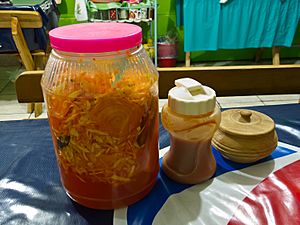
- Cabbage: A very common pickled vegetable, used in many cultures.
- Capers: Small flower buds that are pickled in brine or vinegar, used to add a salty, tangy flavor to many dishes.
- Chanh muối: Vietnamese preserved salty lemons, used in drinks and cooking.
- Chow-chow: A Southern American relish made from a mix of pickled vegetables, often cabbage, green tomatoes, and peppers.
- Curtido: A lightly fermented cabbage relish from El Salvador, often served with pupusas.
- Pickled carrots: Carrots pickled in a tangy solution, often used in sandwiches or as a side dish.
- Pickled cucumbers: Also known as pickles or gherkins, these are one of the most famous pickled foods.
D
- Daikon: A type of radish often pickled in Japan, known as Takuan.
- Dilly beans: Green beans pickled with dill and garlic, giving them a unique flavor.
E
- Pickled eggs: Hard-boiled eggs preserved in a vinegar brine, often with spices.
- Eisbein: A German dish of pickled ham hock, often served with sauerkraut.
F
- Pickled fruit: Many fruits can be pickled, like apples, peaches, or even watermelon rinds.
- Fukujinzuke: A mix of pickled vegetables from Japan, often served with curry.
G
- Gari: Thinly sliced pickled ginger, often served with sushi to cleanse the palate.
- Pickled garlic: Whole garlic cloves pickled in vinegar, offering a milder, tangier garlic flavor.
- Gherkin: A small pickled cucumber.
- Giardiniera: An Italian-American mix of pickled vegetables, often spicy, used as a condiment.
H
- Pickled herring: Fish preserved in a brine or vinegar solution, popular in Scandinavian and European cuisines.
K
- Kimchi: A famous Korean dish of fermented vegetables, most commonly napa cabbage and radishes. It's known for its spicy, sour, and umami flavors.
- Baek-kimchi: A non-spicy white kimchi.
- Dongchimi: A watery kimchi, often served as a cold soup.
- Knieperkohl: A type of sauerkraut from Germany, made from white cabbage, blue cabbage, and sometimes grapes.
L
- Lahpet: Fermented tea leaves from Myanmar, often eaten as a salad.
- Pickled limes: Limes preserved in salt, used in many cuisines for their intense citrus flavor.
M
- Mango pickle: A popular South Asian pickle made from raw mangoes and spices.
- Mixed pickle: A jar containing a variety of pickled vegetables.
- Murături: Romanian pickled vegetables, often including cucumbers, cabbage, and green tomatoes.
- Pickled mustard: Mustard greens or seeds that have been pickled.
N
- Nukazuke: A traditional Japanese method of pickling vegetables in a fermented rice bran paste.
O
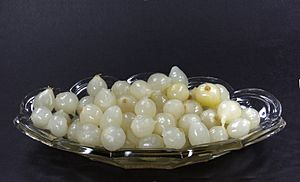
- Pickled onions: Small onions pickled in vinegar, often served with fish and chips or as a snack.
P
- Pao cai: Chinese pickled vegetables, similar to sauerkraut or kimchi.
- Peppadew: A sweet and tangy pickled pepper from South Africa.
- Piccalilli: A British relish made from chopped pickled vegetables and spices.
- Pickled peppers: Various types of peppers, like jalapeños or bell peppers, preserved in vinegar.
- Pickled pigs' feet: A traditional snack in some parts of the world, made from cured and pickled pig's trotters.
- Preserved lemon: Lemons cured in salt and their own juice, used in North African and Middle Eastern cooking.
R
- Pickled radish: Radishes preserved in a tangy brine, often used in Asian cuisines.
- Relish: A cooked and pickled condiment made of chopped vegetables, fruits, or herbs.
- Rollmops: Pickled herring fillets rolled around a piece of pickled gherkin or onion.
S
- Sauerkraut: Finely shredded cabbage that has been fermented by lactic acid bacteria. It's a classic German side dish.
- Pickled seaweed: Various types of seaweed can be pickled, offering a unique salty and umami flavor.
- Suan cai: A traditional Chinese pickled cabbage, similar to sauerkraut.
T
- Takuan: Pickled daikon radish from Japan, known for its crunchy texture and yellow color.
- Torshi: A general term for pickled vegetables in Middle Eastern and Balkan cuisines.
- Tsukemono: A broad category of Japanese pickled vegetables.
- Pickled turnip: Turnips preserved in a brine, often used in Middle Eastern dishes.
U
- Umeboshi: Very sour and salty pickled plums from Japan, often eaten with rice.
W
- Pickled walnuts: Whole walnuts pickled in a spiced vinegar, a traditional British condiment.
- Pickled watermelon rind: The white part of watermelon rind pickled, often sweet and tangy.
Z
- Zha cai: A type of pickled mustard plant stem from Sichuan, China, known for its salty and spicy flavor.
Images for kids
-
A pickled gherkin
-
Pickled herring with onions
-
Takuan is pickled daikon radish.
-
Tursu are the pickled vegetables of the cuisines of many Balkan and Middle East countries.
See also


